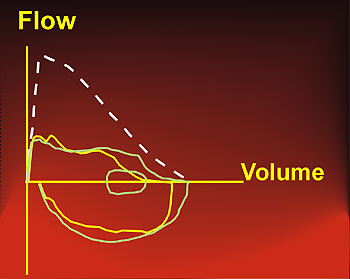| 4 |
 Fixed extensive obstruction of major intrathoracic airway Fixed extensive obstruction of major intrathoracic airway
For example, a tumor obstructing the intrathoracic trachea may increase airway resistance sufficiently to prevent the subject from generating flow sufficiently large to give rise to a flow limiting segment. In the end, unless the pressure drop along airways equals minimally PL,el, an equal pressure point does not occur and a compressed flow limiting segment is not established. However, at low lung volumes the combination of low PL,el and higher peripheral airways resistance do lead to establishment of a flow limiting segment, and possibly to flow limitation on account of progressive airway closure. |